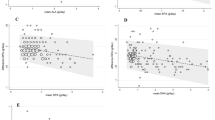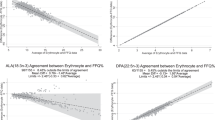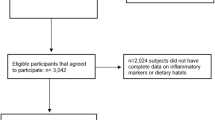Abstract
Background/Objectives:
Limited dietary intake tools have been validated specifically for hyperlipidaemic adults. The Australian Eating Survey (AES) Food Frequency Questionnaire (FFQ) was adapted to include foods with cardio-protective properties (CVD-AES). The aims were to estimate dietary fatty acid (FA) intakes derived from the CVD-AES and AES and compare them with red blood cell (RBC) membrane FA content.
Subjects/Methods:
Dietary intake was measured using the semi-quantitative 120-item AES and 177-item CVD-AES. Nutrient intakes were calculated using AUSNUT 2011–2013. Fasting RBC membrane FAs were assessed using gas chromatography. Extent of agreement between intakes estimated by AES or CVD-AES and RBC membrane composition (% of total FAs) for linoleic acid (LA), alpha-linolenic acid (ALA), eicosapentanoic acid (EPA), docosapentaenoic acid (DPA) and docosahexaenoic acid (DHA) were assessed using Spearman’s correlation coefficients, adjusted linear regressions and Kappa statistics.
Results:
Data from 39 participants (72% female, 59.3±11.1 years) indicate stronger positive correlations between RBC membrane FAs and CVD-AES dietary estimates compared with the AES. Significant (P<0.05) moderate-strong correlations were found between CVD-AES FAs and FA proportions in RBC membranes for EPA (r=0.62), DHA (r=0.53) and DPA (r=0.42), with a moderate correlation for LA (r=0.39) and no correlation with ALA. Significant moderate correlations were found with the AES for DHA (r=0.39), but not for LA, ALA, EPA or DPA.
Conclusions:
The CVD-AES provides a more accurate estimate of long chain FA intakes in hyperlipidaemic adults, compared with AES estimates. This indicates that a CVD-specific FFQ should be used when evaluating FA intakes in this population.
This is a preview of subscription content, access via your institution
Access options
Subscribe to this journal
Receive 12 print issues and online access
$259.00 per year
only $21.58 per issue
Buy this article
- Purchase on Springer Link
- Instant access to full article PDF
Prices may be subject to local taxes which are calculated during checkout

Similar content being viewed by others
References
Franklin BA, Durstine JL, Roberts CK, Barnard RJ . Impact of diet and exercise on lipid management in the modern era. Best Pract Res Clin Endocrinol Metab 2014; 28: 405–421.
Lewington S, Whitlock G, Clarke R, Sherliker P, Emberson J, Hasley J et al. Blood cholesterol and vascular mortality by age, sex, and blood pressure: ci meta-analysis of individual data from 61 prospective studies with 55,000 vascular deaths. Lancet 2007; 370: 1829–1839.
Illner AK, Freisling H, Boeing H, Huybrechts I, Crispim SP, Slimani N . Review and evaluation of innovative technologies for measuring diet in nutritional epidemiology. Int J Epidemiol 2012; 41: 1187–1203.
de Vries J, Antoine JM, Burzykowski T, Chiodini A, Gibney M, Kuhnle G et al. Markers for nutrition studies: review of criteria for the evaluation of markers. Eur J Nutr 2013; 52: 1685–1699.
Katan MB, Deslypere JP, vanBirgelen APJM, Penders M, Zegwaard M . Kinetics of the incorporation of dietary fatty acids into serum cholesteryl esters, erythrocyte membranes, and adipose tissue: an 18-month controlled study. J Lipid Res 1997; 38: 2012–2022.
Arab L . Biomarkers of fat and fatty acid intake. J Nutr 2003; 133 (Suppl 3), 925S–932S.
Arterburn LM, Hall EB, Oken H . Distribution, interconversion, and dose response of n-3 fatty acids in humans. Am J Clin Nutr 2006; 83 (6 Suppl), 1467S–1476S.
Flock MR, Skulas-Ray AC, Harris WS, Etherton TD, Fleming JA, Kris-Etherton PM . Determinants of erythrocyte omega-3 fatty acid content in response to fish oil supplementation: a dose-response randomized controlled trial. J Am Heart Assoc 2013; 2: e000513.
Harris WS . The omega-3 index: clinical utility for therapeutic intervention. Curr Cardiol Rep 2010; 12: 503–508.
Delgado-Lista J, Perez-Martinez P, Lopez-Miranda J, Perez-Jimenez F . Long chain omega-3 fatty acids and cardiovascular disease: a systematic review. Br J Nutr 2012; 107 (Suppl 2), S201–S213.
Kwak SM, Myung SK, Lee YJ, Seo HG, Korean Meta-analysis Study G. Efficacy of omega-3 fatty acid supplements (eicosapentaenoic acid and docosahexaenoic acid) in the secondary prevention of cardiovascular disease: a meta-analysis of randomized, double-blind, placebo-controlled trials. Arch Intern Med 2012; 172: 686–694.
Perk J, De Backer G, Gohlke H, Graham I, Reiner Z, Verschuren M et al. European Guidelines on cardiovascular disease prevention in clinical practice (version 2012). The Fifth Joint Task Force of the European Society of Cardiology and Other Societies on Cardiovascular Disease Prevention in Clinical Practice (constituted by representatives of nine societies and by invited experts). Eur Heart J 2012; 33: 1635–1701.
National Heart Foundation of Australia and the Cardiac Society of Australia and New Zealand Reducing Risk in Heart Disease: An Expert Guide to Clinical Practice for Secondary Prevention of Coronary Heart Disease. National Heart Foundation of Australia: Melbourne, Australia, 2012, pp 1–19.
Dickinson KM, Delaney CL, Allan R, Spark I, Miller MD . Validation of a Brief Dietary Assessment Tool for Estimating Dietary EPA and DHA Intake in Australian Adults at Risk of Cardiovascular Disease. J Am Coll Nutr 2015; 34: 333–339.
Burrows TL, Hutchesson MJ, Rollo ME, Boggess MM, Guest M, Collins CE . Fruit and vegetable intake assessed by food frequency questionnaire and plasma carotenoids: a validation study in adults. Nutrients 2015; 7: 3240–3251.
Rees K, Hartley L, Flowers N, Clarke A, Hooper L, Thorogood M et al. 'Mediterranean' dietary pattern for the primary prevention of cardiovascular disease. Cochrane Database Syst Rev 2013; 8: CD009825.
Jenkins DJ, Jones PJ, Lamarche B, Kendall CW, Faulkner D, Cermakova L et al. Effect of a dietary portfolio of cholesterol-lowering foods given at 2 levels of intensity of dietary advice on serum lipids in hyperlipidemia: a randomized controlled trial. JAMA 2011; 306: 831–839.
Jonklaas J, Bianco AC, Bauer AJ, Burman KD, Cappola AR, Celi FS et al. Guidelines for the treatment of hypothyroidism: prepared by the american thyroid association task force on thyroid hormone replacement. Thyroid 2014; 24: 1670–1751.
GraphPad Software Inc., QuickCalcs La Jolla2012 [updated 12 December 2012; cited 2012 12 December 2012]. 2012: [Random number generator]. Available from http://graphpad.com/quickcalcs/randomN1.cfm.
Collins CE, Boggess MM, Watson JF, Guest M, Duncanson K, Pezdirc K et al. Reproducibility and comparative validity of a food frequency questionnaire for Australian adults. Clin Nutr 2014; 33: 906–914.
Food Standards Australia New Zealand. AUSNUT 2011-2013 Food nutrient database file. 2014. Available from: http://www.foodstandards.gov.au/science/monitoringnutrients/ausnut/ausnutdatafiles/Pages/foodnutrient.aspx.
Food Standards Australia New Zealand. AUSNUT 2011-2013 Dietary supplement nutrient database. 2014. Available from: http://www.foodstandards.gov.au/science/monitoringnutrients/ausnut/ausnutdatafiles/Pages/dietarysupplementnutrient.aspx.
Khoomrung S, Raber G, Laoteng K, Francesconi KA . Identification and characterization of fish oil supplements based on fatty acid analysis combined with a hierarchical clustering algorithm. Eur J Lipid Sci Technol 2014; 116: 795–804.
Lepage G, Roy CC . Direct Transesterification of All Classes of Lipids in a One-Step Reaction. J Lipid Res 1986; 27: 114–120.
Wood LG, Fitzgerald DA, Garg ML . Hypothesis: vitamin E complements polyunsaturated fatty acids in essential fatty acid deficiency in cystic fibrosis. J Am Coll Nutr 2003; 22: 253–257.
Miller M, Stone NJ, Ballantyne C, Bittner V, Criqui MH, Ginsberg HN et al. Triglycerides and cardiovascular disease: a scientific statement from the American Heart Association. Circulation 2011; 123: 2292–2333.
Serra-Majem L, Nissensohn M, Overby NC, Fekete K . Dietary methods and biomarkers of omega 3 fatty acids: a systematic review. Br J Nutr 2012; 107 (Suppl 2), S64–S76.
Turcot V, Brunet J, Daneault C, Tardif JC, Des Rosiers C, Lettre G . Validation of fatty acid intakes estimated by a food frequency questionnaire using erythrocyte fatty acid profiling in the Montreal Heart Institute Biobank. J Hum Nutr Diet 2015; 28: 646–658.
Allaire J, Moreel X, Labonte ME, Leger C, Caron A, Julien P et al. Validation of the omega-3 fatty acid intake measured by a web-based food frequency questionnaire against omega-3 fatty acids in red blood cells in men with prostate cancer. Eur J Clin Nutr 2015; 69: 1004–1008.
Patterson AC, Hogg RC, Kishi DM, Stark KD . Biomarker and dietary validation of a Canadian food frequency questionnaire to measure eicosapentaenoic and docosahexaenoic acid intakes from whole food, functional food, and nutraceutical sources. J Acad Nutr Diet 2012; 112: 1005–1014.
Schuchardt JP, Hahn A . Bioavailability of long-chain omega-3 fatty acids. Prostaglandins, Leukotrienes and Essential Fatty Acids (PLEFA) 2013; 89: 1–8.
Albert BB, Derraik JG, Cameron-Smith D, Hofman PL, Tumanov S, Villas-Boas SG et al. Fish oil supplements in New Zealand are highly oxidised and do not meet label content of n-3 PUFA. Sci Rep 2015; 5: 7928.
Yi T, Li SM, Fan JY, Fan LL, Zhang ZF, Luo P et al. Comparative analysis of EPA and DHA in fish oil nutritional capsules by GC-MS. Lipids Health Dis 2014; 13: 190.
Köhler A, Bittner D, Löw A, von Schacky C . Effects of a convenience drink fortified with n-3 fatty acids on the n-3 index. Br J Nutr 2010; 104: 729–736.
Kirkpatrick SI, Reedy J, Butler EN, Dodd KW, Subar AF, Thompson FE et al. Dietary Assessment in Food Environment Research: A Systematic Review. Am J Prev Med 2014; 46: 94–102.
Acknowledgements
This study forms part of Tracy Schumacher’s PhD thesis. Ethics approval was obtained from the University of Newcastle Human Research Committee, H-2013-0420. The researchers wish to acknowledge Neil J Spratt for his contribution to study design and participant screening and Rebecca Williams for the analysis of the red blood cell membranes. The researchers also wish to acknowledge the support of the HMRI Research Volunteer Register for their assistance in participant recruitment. This study was supported by a grant (HMRI 13–46) from the Hunter Medical Research Institute.
Author information
Authors and Affiliations
Corresponding author
Ethics declarations
Competing interests
The authors declare no conflict of interest.
Additional information
Supplementary Information accompanies this paper on European Journal of Clinical Nutrition website
Supplementary information
Rights and permissions
About this article
Cite this article
Schumacher, T., Burrows, T., Rollo, M. et al. Comparison of fatty acid intakes assessed by a cardiovascular-specific food frequency questionnaire with red blood cell membrane fatty acids in hyperlipidaemic Australian adults: a validation study. Eur J Clin Nutr 70, 1433–1438 (2016). https://doi.org/10.1038/ejcn.2016.144
Received:
Revised:
Accepted:
Published:
Issue Date:
DOI: https://doi.org/10.1038/ejcn.2016.144
This article is cited by
-
HealthyRHearts - reducing cholesterol in rural adults via telehealth-based medical nutrition therapy: protocol for a cluster randomised controlled trial
BMC Cardiovascular Disorders (2023)
-
Evaluation of a Type 2 diabetes risk reduction online program for women with recent gestational diabetes: a randomised trial
International Journal of Behavioral Nutrition and Physical Activity (2022)



